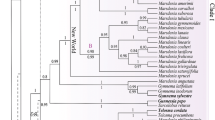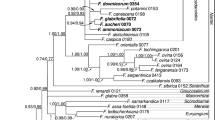Abstract
The tribe Stipeae with an estimated number of ca. 600 species is part of the grass subfamily Pooideae and has near worldwide distribution. Its species are often dominant constituents of steppe vegetation and other grasslands, especially in Eurasia, the Americas and Australia. The taxonomy of Old World Stipeae has been studied to date primarily on the basis of morphology and anatomy, while existing molecular phylogenetic investigations have mainly dealt with New World or Australian taxa. We studied 109 new ingroup taxa with a focus on Old World Stipeae (in addition with an extensive outgroup sampling) using chloroplast and nuclear ribosomal DNA sequences (3′trnK region, ITS1–5.8S gene–ITS2), and discuss taxonomic key characters. Five highly supported monophyletic lineages were identified, some of which were rather unexpected: (a) the narrowly defined Stipa core clade, which is primarily Eurasian but extends into Africa north of the Sahara Desert, (b) the majority of Old World Piptatherum, (c) a “Transcontinental Stipeae Clade” encompassing Eurasian, African, American and Australian lineages, (d) a Himalayan to E Asian clade and (e) the single species Achnatherum splendens. The large “Transcontinental Stipeae Clade” contained several lineages of Eurasian Stipeae different from the Stipa core (a), i.e., genera Aristella, Celtica, Oloptum gen. nov., Stipella stat. et. gen. nov., species of Achnatherum, and the species-rich lineages of Nassella/Jarava in America and of Austrostipa in Australia. In our circumscription Ptilagrostis was nested in (d), a clade (which included some species of Achnatherum and poorly studied Himalayan species ascribed to either Stipa or Orthoraphium) and whose internal structure remained unclear. Oloptum, gen. nov., is described, and the following combinations are made: Achnatherum pelliotii, comb. nov., Aristella keniensis, comb. nov., Oloptum miliaceum, comb. nov., Stipella, stat. et. gen. nov., S. capensis, comb. nov., S. nitens, comb. nov., S. parviflora, comb. nov., S. staintonii, comb. nov., and S. tigrensis, comb. nov.



Similar content being viewed by others
References
Arriaga MO, Barkworth ME (2006) Amelichloa, a new genus in the Stipeae (Poaceae). Sida 22:145–149
Barber JC, Hames KA, Cialdella AM, Giussani LM, Morrone O (2009) Phylogenetic relationships of Piptochaetium Presl (Poaceae: Stipeae) and related genera reconstructed from nuclear and chloroplast sequence data sets. Taxon 58:375–380
Barkworth ME (1990) Nassella (Gramineae: Stipeae): revised interpretation and nomenclatural changes. Taxon 39:597–614
Barkworth ME (1993) North American Stipeae (Gramineae): taxonomic changes and other comments. Phytologia 74:1–25
Barkworth ME (2007) Stipeae Dumort. In: Barkworth ME, Capels KM, Long S, Anderton LK, Piep MB (eds) Flora of North America North of Mexico, vol 24. Oxford University Press, New York, pp 109–187
Barkworth ME, Everett J (1987) Evolution in the Stipeae: identification and relationships of its monophyletic taxa. In: Soderstrom TR, Hilu KW, Campbell CS, Barkworth ME (eds) Grass systematics and evolution. Smithsonian Institution Press, Washington, pp 251–264
Barkworth ME, Torres MA (2001) Distribution and diagnostic characters of Nassella (Poaceae: Stipeae). Taxon 50:439–468
Barkworth ME, Arriaga MO, Smith JF, Jacobs SWL, Valdés-Reyna J, Bushman BS (2008) Molecules and morphology in South American Stipeae (Poaceae). Syst Bot 33:719–731
Bentham G (1883) Gramineae. In: Bentham G, Hooker JD (eds) Genera plantarum, vol 3. D. Reeve & Co., Williams and Norgate, London, pp 1074–1215
Blattner FR (1999) Direct amplification of the entire ITS region from poorly preserved plant material using recombinant PCR. Biotechniques 27:1180–1186
Bouchenak-Khelladi Y, Salamin N, Savolainen V, Forest V, van der Bank M, Chase MW, Hodkinson TR (2008) Large multi-gene phylogenetic trees of the grasses (Poaceae): progress towards complete tribal and generic level sampling. Mol Phylogen Evol 47:488–505
Catalán P, Kellogg EA, Olmstead RG (1997) Phylogeny of Poaceae subfamily Pooideae based on chloroplast ndhF gene sequences. Mol Phylogen Evol 8:150–166
Cialdella AM, Guissani LM, Aagesen L, Zuloaga FO, Morrone O (2007) A phylogeny of Piptochaetium (Poaceae: Pooideae: Stipeae) and related genera based on a combined analysis including trnL–F, rpl16, and morphology. Syst Bot 32:545–559
Clayton WD (1970) Flora of tropical East Africa. Gramineae (Part 1). Crown Agents for Oversea Governments and Administrations, London
Clayton WD, Renvoize SA (1986) Genera graminum. Grasses of the world. (Kew Bull, Add Ser 13). HMSO, London
Clifford HT, Watson L (1977) Identifying grasses: data methods and illustrations. University of Queensland Press, St Lucia
Dahlgren RMT, Clifford HT, Yeo PF (1985) The families of the monocotyledons. Springer, Berlin
Davis JL, Soreng RJ (2007) A preliminary phylogenetic analysis of the grass subfamily Pooideae (Poaceae), with attention to structural features of the plastid and nuclear genomes, including an intron loss in GBSSI. Aliso 23:335–348
Döring E (2009) Molekulare Phylogenie der Hafer-Gräser (Poaceae: Pooideae: Aveneae). PhD thesis, University Halle-Wittenberg, Halle/Saale. http://digital.bibliothek.uni-halle.de/hs/content/titleinfo/177571
Döring E, Schneider J, Hilu KW, Röser M (2007) Phylogenetic relationships in the Aveneae/Poeae complex (Pooideae, Poaceae). Kew Bull 62:407–424
Freitag H (1975) The genus Piptatherum (Gramineae) in southwest and south Asia. Notes R Bot Gard Edinb 33:341–408
Freitag H (1985) The genus Stipa (Gramineae) in southwest and south Asia. Notes R Bot Gard Edinb 42:355–489
Freitag H (1989) Piptatherum and Stipa (Gramineae) in the Arabian Peninsula and tropical East Africa. In: Tan K (ed) The Davis and Hedge festschrift. Edinburgh University Press, Edinburgh, pp 115–132
Grass Phylogeny Working Group (2001) Phylogeny and subfamilial classification of the grasses (Poaceae). Ann Missouri Bot Gard 88:373–457
Hackel E (1887) Gramineae. In: Engler A, Prantl K (eds) Die natürlichen Pflanzenfamilien nebst ihren Gattungen und wichtigeren Arten insbesondere den Nutzpflanzen, vol 2. Verlag von Wilhelm Engelmann, Leipzig, pp 1–97
Jacobs SWL, Everett J (1996) Austrostipa, a new genus, and new names for Australasian species formerly included in Stipa (Gramineae). Telopea 6:579–595
Jacobs SWL, Everett J, Barkworth ME, Hsiao C (2000) Relationships within the stipoid grasses (Gramineae). In: Jacobs SWL, Everett J (eds) Grasses, systematics and evolution. CSIRO Publishing, Melbourne, pp 75–82
Jacobs S, Bayer R, Everett J, Arriaga M, Barkworth M, Sabin-Badereau A, Torres A, Vázquez F, Bagnall N (2007) Systematics of the tribe Stipeae using molecular data. Aliso 23:349–361
Macfarlane TD, Watson L (1982) The classification of Poaceae subfamily Pooideae. Taxon 31:178–203
Matthei O, Marticorena C, Rodríguez R, Kalin Arroyo M, Muñoz M, Squeo FA, Arancio G (1998) Nuevas citas y nuevas combinaciones en Poaceae para la flora de Chile. Gayana Bot 54:189–192
Noltie HJ (1999) Notes relating to the flora of Bhutan: XXXXVIII. Gramineae I, Tribe Stipeae. Edinb J Bot 56:285–291
Noltie HJ (2000) The grasses of Bhutan. Flora of Bhutan, including a record of plants from Sikkim and Darjeeling, vol 3(2). Royal Botanic Garden, Edinburgh
Nylander JAA (2004) MrModeltest 2.3. Program distributed by the author. Evolutionary Biology Centre, Uppsala University, Uppsala
Palisot de Beauvois AMFJ (1812) Essai d’une nouvelle Agrostographie: ou nouveaux genres des Graminées; avec figures représentant les caractères des toutes les genres. Imprimerie de Fain, Paris
Peñailillo P (1996) Anatherostipa, un nuevo genero de Poaceae (Stipeae). Gayana Bot 53:277–284
Peñailillo P (2002) El género Jarava Ruiz et Pav. (Stipeae-Poaceae): delimitación y nuevas combinaciones. Gayana Bot 59:27–34
Peñailillo P (2003) Jarava Ruiz et Pav. In: Soreng RJ, Peterson PM, Davidse G, Judziewicz EJ, Zuloaga FO, Filgueiras TS, Morrone O (eds) Catalogue of New World grasses (Poaceae): IV. Subfamily Pooideae. Contr US Natl Herb 48:402–409
Pilger R (1954) Das System der Gramineae unter Ausschluß der Bambusoideae. Bot Jahrb Syst 76:281–284
Romaschenko K, Peterson PM, Garcia-Jacas J, Soreng RJ, Susanna A (2007) A phylogeny of Stipeae based on nuclear (ITS) sequence data. Abstract available at http://www.2007.botanyconference.org/
Romaschenko K, Peterson PM, Soreng RJ, Garcia-Jacas N, Futoma O, Susanna A (2008) Molecular phylogenetic analysis of the American Stipeae (Poaceae) resolves Jarava sensu lato polyphyletic: evidence for a new genus, Pappostipa. J Bot Res Inst Texas 2:165–192
Romaschenko K, Peterson PM, Soreng RJ, Garcia-Jacas N, Susanna A (2010) Phylogenetics of Stipeae (Poaceae, Pooideae) based on plastid and nuclear DNA sequences. In: Seberg O, Petersen G, Barfod AF, Davis JI (eds) Diversity phylogeny and evolution in the monocotyledons. Aarhus University Press, Århus, pp 511–537
Ronquist F, Huelsenbeck JP (2003) MRBAYES 3: Bayesian phylogenetic inference under mixed models. Bioinformatics 19:1572–1574
Schneider J, Döring E, Hilu KW, Röser M (2009) Phylogenetic structure of the grass subfamily Pooideae based on comparison of plastid matK gene–3′trnK exon and nuclear ITS sequences. Taxon 58:405–424
Soreng RJ, Davis JI (2000) Phylogenetic structure in Poaceae subfamily Pooideae as inferred from molecular and morphological characters: misclassification versus reticulation. In: Jacobs SWL, Everett J (eds) Grasses: systematics and evolution. CSIRO, Melbourne, pp 61–74
Soreng RJ, Peterson PM, Davidse G, Judziewicz EJ, Zuloaga FO, Filgueiras TS, Morrone O (2003) Catalogue of New World grasses (Poaceae): IV. Subfamily Pooideae. Contr US Natl Herb 48:1–730
Swofford DL (2002) PAUP* phylogenetic analysis using parsimony (* and other methods). Version 10. Sinauer Associates, Sunderland
Torres MA (1997) Nicoraella (Gramineae) un nuevo género para América del Sur. Comisión de Investigaciones Cientificas, Monografía 13:63–76
Tzvelev NN (1974) Notulae de tribu Stipeae Dum. (Fam. Poaceae) in URSS. Novosty Sist Vysš Rast 11:4–21
Tzvelev NN (1976) Grasses of the Soviet Union, vols I and II. Nauka, Leningrad. English translation 1983. Oxonion Press, New Delhi
Tzvelev NN (1977) On the origin and evolution of the feathergrasses (Stipa L.). In Problemii ekologii, geobotaniki, and botaniicheskoi geografii i floristickii. Leningrad, Nauka. [In Russian; translation by K. Gonzales, available at http://utc.usu.edu/Stipeae/Tsvelev.htm], pp 139–150
Tzvelev NN (1989) The system of grasses (Poaceae) and their evolution. Bot Rev 55:141–203
Tzvelev NN (2001) Volume 4, Gramineae (Grasses). In: Grubov VI (ed) Plants of Central Asia, plant collections from China and Mongolia. Science Publishers, Enfield, Plymouth
Vázquez FM, Barkworth ME (2004) Resurrection and emendation of Macrochloa (Gramineae: Stipeae). Bot J Linn Soc 144:483–495
Veldkamp JF (1985) Anemanthele Veldk. (Gramineae: Stipeae), a new genus from New Zealand. Acta Bot Neerl 34:105–109
Watson L, Dallwitz MJ (1992a) The grass genera of the world. CAB International, Wallingford
Watson L, Dallwitz MJ (1992b) The grass genera of the world: descriptions, illustrations, identification, and information retrieval; including synonyms, morphology, anatomy, physiology, phytochemistry, cytology, classification, pathogens, world and local distribution, and references. Version: 25th November 2008. http://delta-intkey.com
Wheeler DJB, Jacobs SWL, Norton BE (1982) Grasses of New South Wales. University of New England Press, Armidale
Wu Z-Y, Phillips SM (2006) Stipeae. In: Wu Z-Y, Raven PH, Hong DY (eds) Flora of China, vol 22. Science Press, Missouri Botanical Garden Press, Beijing, St. Louis, pp 188–212
Acknowledgments
We would especially like to thank H. Freitag (University of Kassel, Germany) for generously providing plant material from his collection and for valuable comments on the manuscript. We are grateful to I. Hensen (University Halle-Wittenberg, Germany), G. and S. Miehe (University Marburg, Germany) and M.V. Olonova (Tomsk State University, Russia) for supplying plant material for this study. We also thank B. Hildebrandt for excellent technical assistance and J. Schneider for providing the outgroup sequence data (University of Halle-Wittenberg). The study was supported by a Grant from the German Academic Exchange Programme (DAAD) to HRH and a research grant from the German Research Foundation (DFG) to MR.
Author information
Authors and Affiliations
Corresponding author
Electronic supplementary material
Below is the link to the electronic supplementary material.
Rights and permissions
About this article
Cite this article
Hamasha, H.R., von Hagen, K.B. & Röser, M. Stipa (Poaceae) and allies in the Old World: molecular phylogenetics realigns genus circumscription and gives evidence on the origin of American and Australian lineages. Plant Syst Evol 298, 351–367 (2012). https://doi.org/10.1007/s00606-011-0549-5
Received:
Accepted:
Published:
Issue Date:
DOI: https://doi.org/10.1007/s00606-011-0549-5




